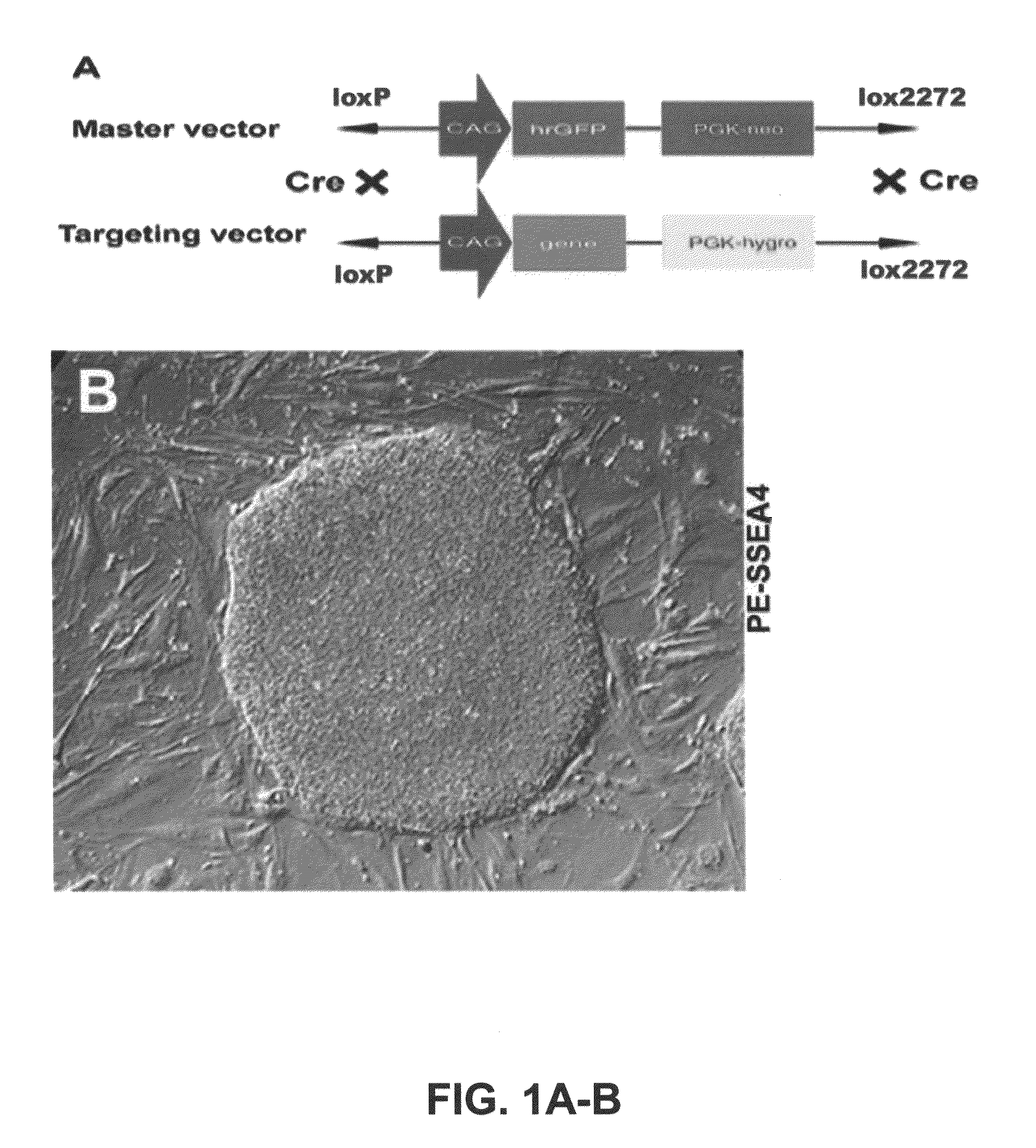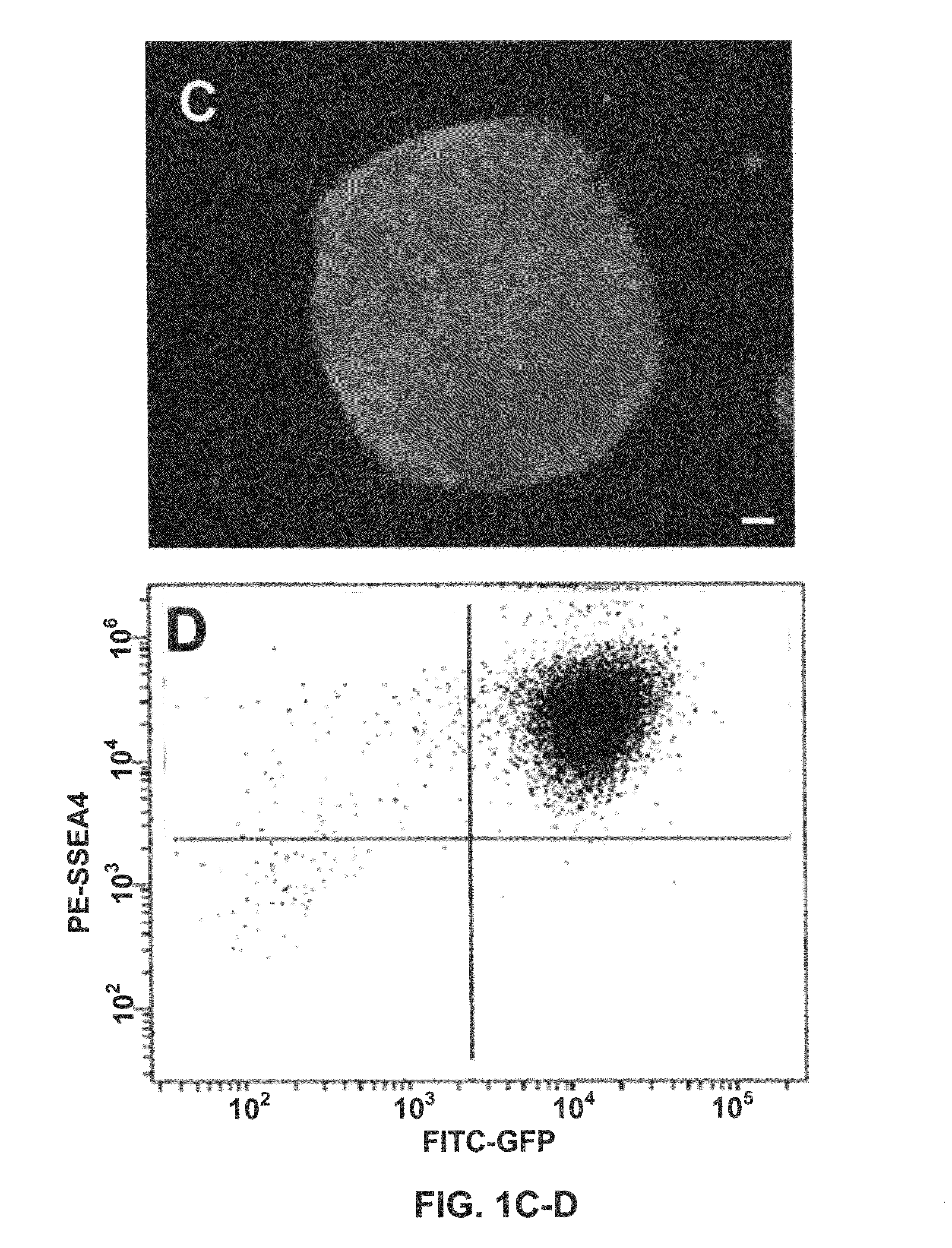Gene recombination exchange system for stable gene modification in human ES cells
a gene recombination exchange and gene technology, applied in the field of gene recombination exchange system for stable gene modification in human es cells, can solve the problems of less suitable methods for generating stable hesc clones, difficult and laborious process of building stable transgenic hesc lines, and a risk of insertional mutagenesis, so as to improve the efficiency of cre-mediated recombination
- Summary
- Abstract
- Description
- Claims
- Application Information
AI Technical Summary
Benefits of technology
Problems solved by technology
Method used
Image
Examples
example 1
Creation of Transgenic hESC Line
[0048]We described a transgene integration strategy employing the recombination mediated cassette exchange (RMCE) system for establishment of human embryonic stem cells (hESC) lines carrying versatile transgenic modification. Two master hESC lines with a built-in double loxP recombination exchange cassette were screened out to integrate into new silencing-resistant sites and to sustain the transgene (GFP) expression during differentiation into cells representing the three germ layers. Using a cell permeable Cre protein transduction method, the double loxP cassette in the master cell lines was successfully and specifically exchanged with multiple targeting transgene cassettes, including constitutive functional gene expression, cell lineage specific reporter gene expression and inducible transgene expression. This strategy and the master cell lines will allow for rapid production of transgenic hESC lines, thus facilitating analysis of gene function invo...
example 2
Identification of Insertion Sites
Site-finding PCR
[0083]The transgene integration site was determined by site-finding PCR analysis. Tan G, Gao Y, Shi M et al. Nucleic Acids Res. 2005; 33:e122. The site-finding PCR mixture included 2 μl of 10× long Taq DNA polymerase buffer, 2 μl of 10 mM dNTP solution, 0.5 U of long Taq DNA polymerase (Epicenter), 10 μmol of SiteFinder primer (5′-CAC GAC ACG CTA CTC AAC ACA CCA CCT CGC ACA GCG TCA TCA AGC GGC CGC NNN NNN GCC T-3′ (SEQ ID NO:7)) and 100 ng of genomic DNA extracted from hESC samples. The final volume was brought to 20 μl with water, and then a single PCR cycle was run. This was followed by two rounds of nested PCR using the following primers, respectively, SFP1 (5′-CAC GAC ACG CTA CTC AAC AC-3′ (SEQ ID NO:8)), GSP1 (5′-TAT CCC GTA TTG ACG CCG GGC AAG-3′ (SEQ ID NO:9)), SFP2 (5′-ACT CAA CAC ACC ACC TCG CAC AGC-3′ (SEQ ID NO:10)), GSP2 (5′-AAG AGC AAC TCG GTC GCC GCA TAC-3′ (SEQ ID NO:11)). SFP1 and SFP2 were nested primer from SiteFinde...
PUM
| Property | Measurement | Unit |
|---|---|---|
| concentrations | aaaaa | aaaaa |
| concentrations | aaaaa | aaaaa |
| concentrations | aaaaa | aaaaa |
Abstract
Description
Claims
Application Information
 Login to View More
Login to View More - R&D Engineer
- R&D Manager
- IP Professional
- Industry Leading Data Capabilities
- Powerful AI technology
- Patent DNA Extraction
Browse by: Latest US Patents, China's latest patents, Technical Efficacy Thesaurus, Application Domain, Technology Topic, Popular Technical Reports.
© 2024 PatSnap. All rights reserved.Legal|Privacy policy|Modern Slavery Act Transparency Statement|Sitemap|About US| Contact US: help@patsnap.com










